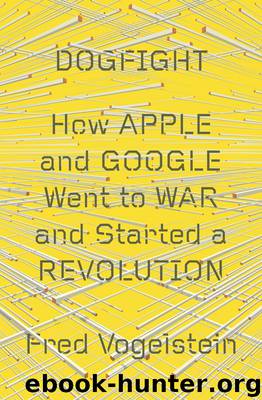Dogfight: How Apple and Google Went to War and Started a Revolution by Vogelstein Fred

Author:Vogelstein, Fred [Vogelstein, Fred]
Language: eng
Format: epub, mobi, azw3
Publisher: Farrar, Straus and Giroux
Published: 2013-11-12T00:00:00+00:00
6
Android Everywhere
By 2010 Apple and Google were attacking each other on every possible front: in the courts, in the media, and in the marketplace. Android’s surge in popularity was astonishing, and Rubin, Schmidt, and the rest of Google made no secret of their glee. It seemed that every chance they got during 2010 they would expound on how many monthly activations Android had racked up and how mobile devices were going to change the future of Google and the world. In an April 2010 interview with The New York Times, Rubin even predicted that Android was going to rule the entire mobile universe. The year before he had been worried that Google would abandon Android and that he and his team would need to job hunt. Now he confidently proclaimed, “It [Android] is a numbers game. When you have multiple OEM’s [phone manufacturers] building multiple products in multiple product categories, it’s just a matter of time” before Android overtakes other smartphone platforms such as iPhone and the BlackBerry.
It was as if little else about Google mattered anymore. That wasn’t really true, but it wasn’t a huge exaggeration either. In 2010, Android started the year with 7 million users. By year-end it had grown to 67 million and was adding three hundred thousand new customers a day. Android itself wasn’t making money yet, but it was heading there fast. More important, it was accelerating the revenue and profit growth of other Google applications such as search and YouTube, and it was getting more people to sign up for Google accounts and give Google their credit-card information. The more people used Android, the more Google searches they did and the more ads they clicked on.
Google still made most of its money from searches on laptops and desktops. But everyone at the top of the company knew they wouldn’t be the dominant source of revenue forever. Soon, fewer and fewer people would be buying those devices, and more and more would be buying smartphones and other mobile gadgets with Internet access. The growth and profits for Google lurking in these numbers were eye-popping. Each mobile-phone ad might sell for less than a desktop ad, but its potential audience and, therefore, total revenue potential were enormous. Consumers buy five times more cell phones every year than PCs—1.8 billion versus 400 million. Google had barely penetrated this market.
Thanks to Android, Google’s potential audience for its ads and applications had quintupled.
It had all worked almost exactly the way Rubin had envisioned it would too: manufacturers and carriers wanted to compete with the iPhone, and Rubin’s success with the Droid had convinced them that Android was their best chance of doing that. Rubin took full advantage of the opportunity, pushing his engineers to deliver three major updates to the Android software in 2010—a relentless pace. By the end of 2010 Android didn’t just have monster hits such as the Droid, but a handful of others such as HTC’s Evo 4G and Samsung’s Galaxy S. In all, by
Download
Dogfight: How Apple and Google Went to War and Started a Revolution by Vogelstein Fred.mobi
Dogfight: How Apple and Google Went to War and Started a Revolution by Vogelstein Fred.azw3
This site does not store any files on its server. We only index and link to content provided by other sites. Please contact the content providers to delete copyright contents if any and email us, we'll remove relevant links or contents immediately.
| Antennas | Microwaves |
| Mobile & Wireless | Networks |
| Radar | Radio |
| Remote Sensing & GIS | Satellite |
| Signal Processing | Telephone Systems |
| Television & Video |
Whiskies Galore by Ian Buxton(41867)
Introduction to Aircraft Design (Cambridge Aerospace Series) by John P. Fielding(33064)
Small Unmanned Fixed-wing Aircraft Design by Andrew J. Keane Andras Sobester James P. Scanlan & András Sóbester & James P. Scanlan(32743)
Craft Beer for the Homebrewer by Michael Agnew(18140)
Turbulence by E. J. Noyes(7935)
The Complete Stick Figure Physics Tutorials by Allen Sarah(7307)
Kaplan MCAT General Chemistry Review by Kaplan(6866)
The Thirst by Nesbo Jo(6826)
Bad Blood by John Carreyrou(6543)
Modelling of Convective Heat and Mass Transfer in Rotating Flows by Igor V. Shevchuk(6391)
Learning SQL by Alan Beaulieu(6208)
Weapons of Math Destruction by Cathy O'Neil(6139)
Man-made Catastrophes and Risk Information Concealment by Dmitry Chernov & Didier Sornette(5921)
Digital Minimalism by Cal Newport;(5661)
Life 3.0: Being Human in the Age of Artificial Intelligence by Tegmark Max(5474)
iGen by Jean M. Twenge(5366)
Secrets of Antigravity Propulsion: Tesla, UFOs, and Classified Aerospace Technology by Ph.D. Paul A. Laviolette(5309)
Design of Trajectory Optimization Approach for Space Maneuver Vehicle Skip Entry Problems by Runqi Chai & Al Savvaris & Antonios Tsourdos & Senchun Chai(5011)
Electronic Devices & Circuits by Jacob Millman & Christos C. Halkias(4907)
